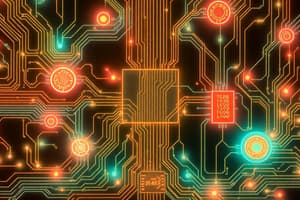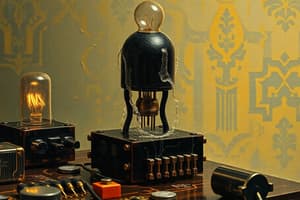Podcast
Questions and Answers
What is the primary function of the base-emitter junction in a BJT transistor?
What is the primary function of the base-emitter junction in a BJT transistor?
- To block the input signal
- To amplify the input signal (correct)
- To act as a capacitor
- To control the output current
Which mode of operation allows a BJT transistor to act as an amplifier?
Which mode of operation allows a BJT transistor to act as an amplifier?
- Ohmic mode
- Cut-off mode
- Saturation mode
- Active mode (correct)
What is the primary difference between an NPN and a PNP BJT transistor?
What is the primary difference between an NPN and a PNP BJT transistor?
- The number of layers
- The type of semiconductor material used
- The polarity of the voltage applied (correct)
- The direction of current flow
Which of the following is an application of FET transistors?
Which of the following is an application of FET transistors?
What is the primary advantage of FET transistors over BJT transistors?
What is the primary advantage of FET transistors over BJT transistors?
In which mode of operation does a FET transistor act as a resistor?
In which mode of operation does a FET transistor act as a resistor?
What is the primary function of the gate-source junction in a FET transistor?
What is the primary function of the gate-source junction in a FET transistor?
Which type of transistor is more suitable for low-frequency applications?
Which type of transistor is more suitable for low-frequency applications?
What is the primary disadvantage of BJT transistors?
What is the primary disadvantage of BJT transistors?
What is a common application of both BJT and FET transistors?
What is a common application of both BJT and FET transistors?
Flashcards are hidden until you start studying
Study Notes
BJT Transistors
Structure
- Consist of three layers: emitter, base, and collector
- Two types: NPN (negative-positive-negative) and PNP (positive-negative-positive)
Operation
- Current flows from emitter to collector, controlled by base-emitter voltage
- Base-emitter junction acts as an amplifier, allowing small input signal to control large output current
Modes of Operation
- Active mode: transistor acts as an amplifier, allowing current to flow from emitter to collector
- Cut-off mode: transistor is fully turned off, no current flows between emitter and collector
- Saturation mode: transistor is fully turned on, maximum current flows between emitter and collector
Applications
- Amplifiers
- Switches
- Logic gates
FET Transistors
Structure
- Consist of three layers: source, gate, and drain
- Two types: N-channel and P-channel
Operation
- Current flows from source to drain, controlled by gate-source voltage
- Gate-source junction acts as a capacitor, allowing small input signal to control large output current
Modes of Operation
- Ohmic mode: transistor acts as a resistor, allowing current to flow from source to drain
- Saturation mode: transistor is fully turned on, maximum current flows between source and drain
- Cut-off mode: transistor is fully turned off, no current flows between source and drain
Applications
- Amplifiers
- Switches
- Logic gates
- Integrated circuits
Comparison of BJT and FET Transistors
- BJT: high current gain, high input impedance, but requires more power to operate
- FET: low current gain, high input impedance, but requires less power to operate
- FET is more suitable for high-frequency applications, while BJT is more suitable for low-frequency applications
BJT Transistors
Structure
- Composed of three layers: emitter, base, and collector
- NPN (negative-positive-negative) and PNP (positive-negative-positive) are the two main types
Operation
- Current flow from emitter to collector is controlled by the base-emitter voltage
- Base-emitter junction acts as an amplifier, enabling small input signals to control large output currents
Modes of Operation
- Active mode: transistor acts as an amplifier, allowing current to flow from emitter to collector
- Cut-off mode: transistor is fully turned off, preventing current flow between emitter and collector
- Saturation mode: transistor is fully turned on, resulting in maximum current flow between emitter and collector
Applications
- Amplifiers: BJT transistors are used to amplify weak electrical signals
- Switches: BJT transistors are used to switch electronic circuits on and off
- Logic gates: BJT transistors are used to create logical operations in digital circuits
FET Transistors
Structure
- Composed of three layers: source, gate, and drain
- N-channel and P-channel are the two main types
Operation
- Current flow from source to drain is controlled by the gate-source voltage
- Gate-source junction acts as a capacitor, enabling small input signals to control large output currents
Modes of Operation
- Ohmic mode: transistor acts as a resistor, allowing current to flow from source to drain
- Saturation mode: transistor is fully turned on, resulting in maximum current flow between source and drain
- Cut-off mode: transistor is fully turned off, preventing current flow between source and drain
Applications
- Amplifiers: FET transistors are used to amplify weak electrical signals
- Switches: FET transistors are used to switch electronic circuits on and off
- Logic gates: FET transistors are used to create logical operations in digital circuits
- Integrated circuits: FET transistors are used in the construction of integrated circuits
Comparison of BJT and FET Transistors
- BJT transistors have high current gain, high input impedance, but require more power to operate
- FET transistors have low current gain, high input impedance, but require less power to operate
- FET transistors are more suitable for high-frequency applications, while BJT transistors are more suitable for low-frequency applications
Studying That Suits You
Use AI to generate personalized quizzes and flashcards to suit your learning preferences.




